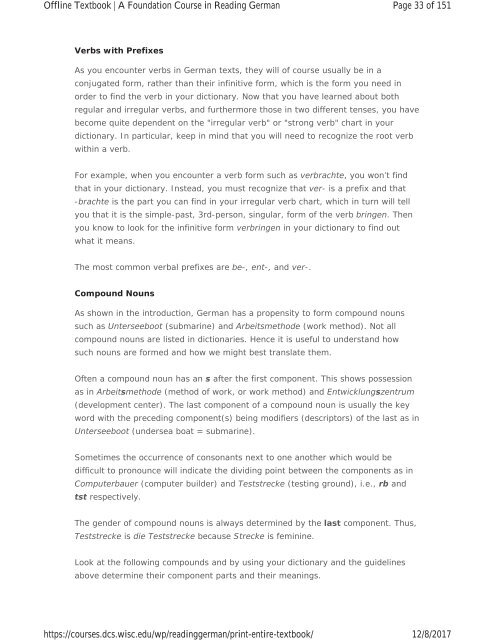A Foundation Course in Reading German, 2017a
A Foundation Course in Reading German, 2017a
A Foundation Course in Reading German, 2017a
Create successful ePaper yourself
Turn your PDF publications into a flip-book with our unique Google optimized e-Paper software.
Offl<strong>in</strong>e Textbook | A <strong>Foundation</strong> <strong>Course</strong> <strong>in</strong> Read<strong>in</strong>g <strong>German</strong><br />
https://courses.dcs.wisc.edu/wp/read<strong>in</strong>ggerman/pr<strong>in</strong>t-entire-textbook/<br />
Page 33 of 151<br />
12/8/2017<br />
Verbs with Prefixes<br />
As you encounter verbs <strong>in</strong> <strong>German</strong> texts, they will of course usually be <strong>in</strong> a<br />
conjugated form, rather than their <strong>in</strong>f<strong>in</strong>itive form, which is the form you need <strong>in</strong><br />
order to f<strong>in</strong>d the verb <strong>in</strong> your dictionary. Now that you have learned about both<br />
regular and irregular verbs, and furthermore those <strong>in</strong> two different tenses, you have<br />
become quite dependent on the "irregular verb" or "strong verb" chart <strong>in</strong> your<br />
dictionary. In particular, keep <strong>in</strong> m<strong>in</strong>d that you will need to recognize the root verb<br />
with<strong>in</strong> a verb.<br />
For example, when you encounter a verb form such as verbrachte, you won’t f<strong>in</strong>d<br />
that <strong>in</strong> your dictionary. Instead, you must recognize that ver- is a prefix and that<br />
-brachte is the part you can f<strong>in</strong>d <strong>in</strong> your irregular verb chart, which <strong>in</strong> turn will tell<br />
you that it is the simple-past, 3rd-person, s<strong>in</strong>gular, form of the verb br<strong>in</strong>gen. Then<br />
you know to look for the <strong>in</strong>f<strong>in</strong>itive form verbr<strong>in</strong>gen <strong>in</strong> your dictionary to f<strong>in</strong>d out<br />
what it means.<br />
The most common verbal prefixes are be-, ent-, and ver-.<br />
Compound Nouns<br />
As shown <strong>in</strong> the <strong>in</strong>troduction, <strong>German</strong> has a propensity to form compound nouns<br />
such as Unterseeboot (submar<strong>in</strong>e) and Arbeitsmethode (work method). Not all<br />
compound nouns are listed <strong>in</strong> dictionaries. Hence it is useful to understand how<br />
such nouns are formed and how we might best translate them.<br />
Often a compound noun has an s after the first component. This shows possession<br />
as <strong>in</strong> Arbeitsmethode (method of work, or work method) and Entwicklungszentrum<br />
(development center). The last component of a compound noun is usually the key<br />
word with the preced<strong>in</strong>g component(s) be<strong>in</strong>g modifiers (descriptors) of the last as <strong>in</strong><br />
Unterseeboot (undersea boat = submar<strong>in</strong>e).<br />
Sometimes the occurrence of consonants next to one another which would be<br />
difficult to pronounce will <strong>in</strong>dicate the divid<strong>in</strong>g po<strong>in</strong>t between the components as <strong>in</strong><br />
Computerbauer (computer builder) and Teststrecke (test<strong>in</strong>g ground), i.e., rb and<br />
tst respectively.<br />
The gender of compound nouns is always determ<strong>in</strong>ed by the last component. Thus,<br />
Teststrecke is die Teststrecke because Strecke is fem<strong>in</strong><strong>in</strong>e.<br />
Look at the follow<strong>in</strong>g compounds and by us<strong>in</strong>g your dictionary and the guidel<strong>in</strong>es<br />
above determ<strong>in</strong>e their component parts and their mean<strong>in</strong>gs.


















